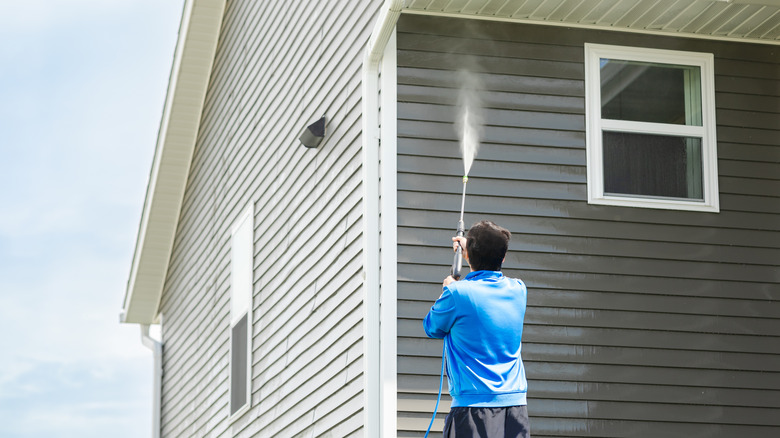
If your home’s exterior paint is starting to look dull, dusty, or stained, you might be tempted to bring out the power washer for a fast refresh. But many homeowners worry: Does power washing affect my home’s exterior paint? Could blasting the surface with water actually damage the paint instead of cleaning it?
The answer is: Yes — power washing can affect your home’s paint, both positively and negatively. It depends on how you do it, what type of paint you have, and the condition of the surface. Let’s break down the risks, rewards, and best practices to keep your home looking its best. 🏡🧼
✅ What Power Washing Can Do for Painted Surfaces
When done correctly, power washing offers several benefits:
- 🌟 Restores color by removing dust, pollen, mildew, and grime
- 🧽 Prepares surfaces for repainting or staining by stripping away peeling paint and contaminants
- 🧼 Improves curb appeal without repainting
- 🐛 Washes away cobwebs, algae, and bird droppings
In short, it can rejuvenate your exterior — but only if done with proper technique and settings.
⚠️ When Power Washing Damages Paint
Power washing becomes a problem when:
- 💥 Too much pressure is used
- 🧱 Old, brittle, or peeling paint is already present
- 🪵 Wood siding or trim isn’t sealed properly
- 🎨 Painted stucco is hit with high PSI
- 🧴 Harsh chemicals are used improperly
The result? You could strip paint unintentionally, leave streaks, or even expose bare material beneath. On older homes, power washing can cause large patches of paint to peel or flake off. 😬
🔧 Recommended PSI for Painted Surfaces
Always use the lowest pressure that gets the job done. For most painted exteriors:
- Wood siding: 500–800 PSI
- Vinyl siding (painted): 1,200–1,500 PSI
- Fiber cement or stucco: 1,200 PSI or less
- Aluminum siding: 1,000–1,300 PSI
Stick with a 25° (green) or 40° (white) nozzle and keep the spray at least 12–18 inches away from the surface.
Browse Amazon Here For Top Rated Power Washers And Accessories
🧼 How to Power Wash Painted Surfaces Safely
1. Inspect the Paint First
Look for peeling, flaking, bubbling, or chalking. If the paint is damaged or loose, avoid power washing — it could worsen the issue.
2. Choose the Right Detergent
Use a mild exterior house cleaner that’s safe for painted surfaces. Avoid bleach-heavy formulas unless diluted properly.
3. Test a Small Area
Start in an inconspicuous spot. Check for any discoloration, lifting paint, or damage after rinsing.
4. Apply Detergent from Bottom to Top
This prevents streaks and gives more even coverage.
5. Rinse From Top to Bottom
Use low to moderate pressure, and never spray directly into gaps, vents, or under siding edges.
Browse Amazon Here For Popular Power Washing Detergents
🧠 When NOT to Power Wash Painted Surfaces
Skip power washing if:
- Your house has lead-based paint (common in homes built before 1978)
- The exterior is already cracking or flaking
- You plan to paint without stripping old paint
- The paint has a chalky or powdery surface (this may need special treatment first)
In these cases, soft washing or hand-cleaning may be better — or consult a pro.
🪜 Should You Power Wash Before Repainting?
Yes — and in most cases, it’s absolutely essential.
Power washing removes:
- Dirt, dust, and loose debris
- Mold, mildew, and algae
- Old, peeling paint
- Residue from previous coatings
This gives your new paint a clean, sound surface to stick to, which helps prevent premature failure, bubbling, or cracking.
💡 Just be sure to allow at least 24–48 hours of drying time after washing before applying new paint.
🧰 Extra Tips for Painted Exterior Care
- ✅ Avoid pressure above 1,500 PSI on any painted surface
- ✅ Use a fan spray tip, not a pinpoint nozzle
- ✅ Angle the spray downward, never upward into siding
- ✅ Don’t hold the spray in one spot for more than 2–3 seconds
- ✅ Rinse plants and landscaping before and after cleaning
These small details make a big difference in protecting your home’s paint job. 🎯
🛑 Common Mistakes to Avoid
- ❌ Using a turbo nozzle (too harsh)
- ❌ Washing in direct sunlight (can cause streaking and drying issues)
- ❌ Forgetting to rinse detergent thoroughly
- ❌ Spraying old wood with cracked or peeling paint
- ❌ Overrelying on pressure instead of detergent and technique
Power washing isn’t about brute force — it’s about precision and control. 🧠
🏁 Final Thoughts
So, does power washing affect your home’s exterior paint? Absolutely — and it can be a good thing or a bad thing, depending on how you do it.
Done right, it:
- Enhances the look of your home
- Preps the surface for repainting
- Helps paint last longer and look better
But done wrong, it can strip paint, cause damage, or force water into your home.
Use the right pressure, the right tools, and the right prep — and you’ll enjoy a cleaner, more vibrant home without any surprises. 🎨✨🏠
Browse Amazon Here For Top Rated Power Washers And Accessories






